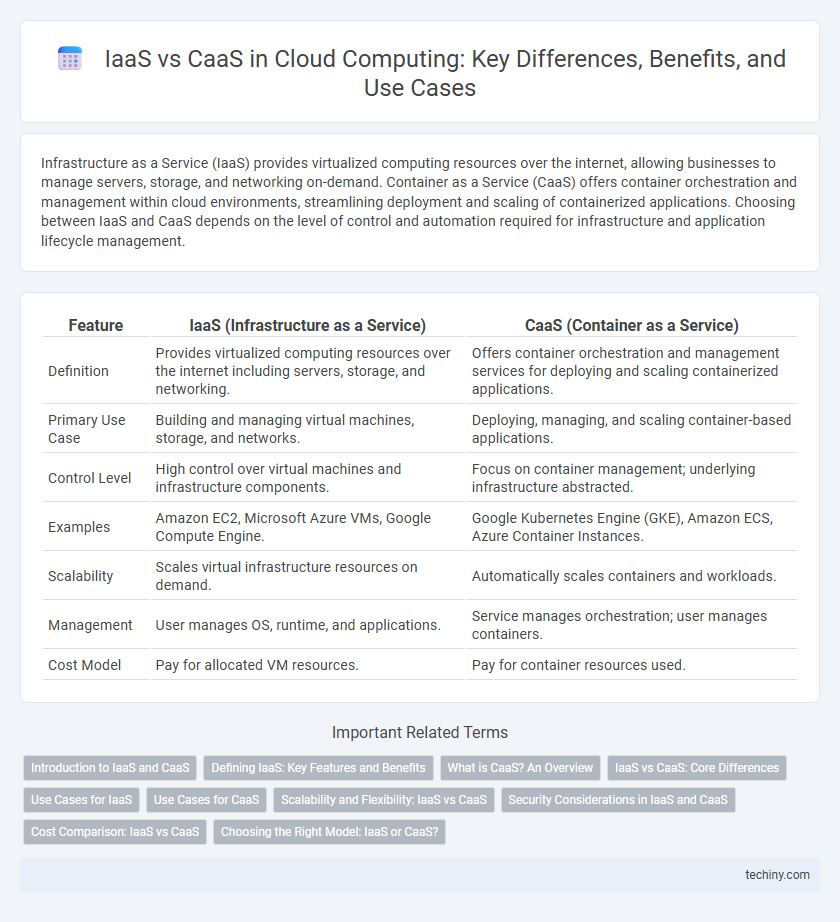Infrastructure as a Service (IaaS) provides virtualized computing resources over the internet, allowing businesses to manage servers, storage, and networking on-demand. Container as a Service (CaaS) offers container orchestration and management within cloud environments, streamlining deployment and scaling of containerized applications. Choosing between IaaS and CaaS depends on the level of control and automation required for infrastructure and application lifecycle management.
Table of Comparison
| Feature | IaaS (Infrastructure as a Service) | CaaS (Container as a Service) |
|---|---|---|
| Definition | Provides virtualized computing resources over the internet including servers, storage, and networking. | Offers container orchestration and management services for deploying and scaling containerized applications. |
| Primary Use Case | Building and managing virtual machines, storage, and networks. | Deploying, managing, and scaling container-based applications. |
| Control Level | High control over virtual machines and infrastructure components. | Focus on container management; underlying infrastructure abstracted. |
| Examples | Amazon EC2, Microsoft Azure VMs, Google Compute Engine. | Google Kubernetes Engine (GKE), Amazon ECS, Azure Container Instances. |
| Scalability | Scales virtual infrastructure resources on demand. | Automatically scales containers and workloads. |
| Management | User manages OS, runtime, and applications. | Service manages orchestration; user manages containers. |
| Cost Model | Pay for allocated VM resources. | Pay for container resources used. |
Introduction to IaaS and CaaS
Infrastructure as a Service (IaaS) provides virtualized computing resources over the internet, enabling businesses to rent servers, storage, and networking components on a scalable pay-as-you-go basis. Containers as a Service (CaaS) offers container orchestration and management platforms, facilitating deployment, scaling, and operation of containerized applications without managing the underlying infrastructure. IaaS focuses on virtual machines and raw computing power, while CaaS accelerates application development through container-based environments.
Defining IaaS: Key Features and Benefits
IaaS (Infrastructure as a Service) provides virtualized computing resources over the internet, including servers, storage, and networking, enabling scalable and flexible IT infrastructure management. Key features of IaaS include on-demand resource provisioning, automated administrative tasks, and pay-as-you-go pricing models that reduce capital expenditure. Benefits of IaaS encompass increased agility, improved business continuity, and seamless integration with existing cloud services, empowering organizations to optimize operational efficiency.
What is CaaS? An Overview
Container as a Service (CaaS) is a cloud computing service model that provides container orchestration and management capabilities on demand, enabling developers to deploy, manage, and scale containerized applications efficiently. Unlike Infrastructure as a Service (IaaS), which offers virtualized hardware resources such as servers and storage, CaaS focuses specifically on container technology with integrated tools like Kubernetes for automation and orchestration. This service accelerates application development and deployment by abstracting infrastructure complexity and optimizing resource utilization in cloud environments.
IaaS vs CaaS: Core Differences
Infrastructure as a Service (IaaS) provides virtualized computing resources over the internet, including servers, storage, and networking, allowing users to manage operating systems and applications. Container as a Service (CaaS) focuses specifically on container management and orchestration, enabling deployment, scaling, and operation of containerized applications. The core difference lies in IaaS offering broad infrastructure components, while CaaS delivers specialized container environment automation and lifecycle management.
Use Cases for IaaS
IaaS (Infrastructure as a Service) is ideal for businesses requiring scalable computing resources, such as startups deploying web applications or enterprises running big data analytics. It provides virtualized hardware like servers, storage, and networking, enabling development teams to quickly provision and manage IT infrastructure without investing in physical equipment. Common use cases include disaster recovery, high-performance computing, and hosting test and development environments.
Use Cases for CaaS
Container as a Service (CaaS) excels in managing containerized applications with scalable orchestration, making it ideal for microservices architectures, continuous integration/continuous deployment (CI/CD) pipelines, and agile software development environments. Enterprises leverage CaaS for seamless application portability across hybrid and multi-cloud infrastructures, streamlining resource allocation and improving operational efficiency. Use cases also include automated container management, rapid application scaling, and efficient workload isolation in DevOps-driven organizations.
Scalability and Flexibility: IaaS vs CaaS
IaaS offers high scalability by providing virtualized hardware resources such as servers, storage, and networks that can be adjusted on demand to meet fluctuating workloads. CaaS enhances flexibility by enabling container orchestration and management, allowing rapid deployment, scaling, and automation of containerized applications across diverse environments. Both platforms optimize resource allocation, but CaaS delivers finer granularity in scalability and application portability compared to traditional IaaS infrastructures.
Security Considerations in IaaS and CaaS
IaaS security emphasizes infrastructure control, requiring users to manage virtual machines, firewalls, and access permissions to safeguard data, while providers handle physical hardware security. CaaS introduces container-specific security challenges such as isolation between containers, secure image management, and orchestration platform vulnerabilities. Both models demand robust identity and access management (IAM) policies and continuous monitoring to prevent unauthorized access and ensure compliance.
Cost Comparison: IaaS vs CaaS
IaaS typically involves higher upfront and operational costs due to resource provisioning and management complexity, whereas CaaS reduces expenses by leveraging containerization for efficient resource utilization and faster deployment. Enterprises adopting CaaS benefit from lower infrastructure overhead and optimized scaling, resulting in improved cost efficiency compared to traditional IaaS models. Cost savings in CaaS become more significant with increased workload automation and microservices adoption.
Choosing the Right Model: IaaS or CaaS?
Choosing between Infrastructure as a Service (IaaS) and Containers as a Service (CaaS) depends on the level of control and scalability required. IaaS provides virtualized computing resources, making it ideal for businesses needing customizable infrastructure and VM-level control. CaaS offers container orchestration and management, best suited for developers focusing on application deployment, portability, and microservices architecture.
IaaS vs CaaS Infographic

 techiny.com
techiny.com